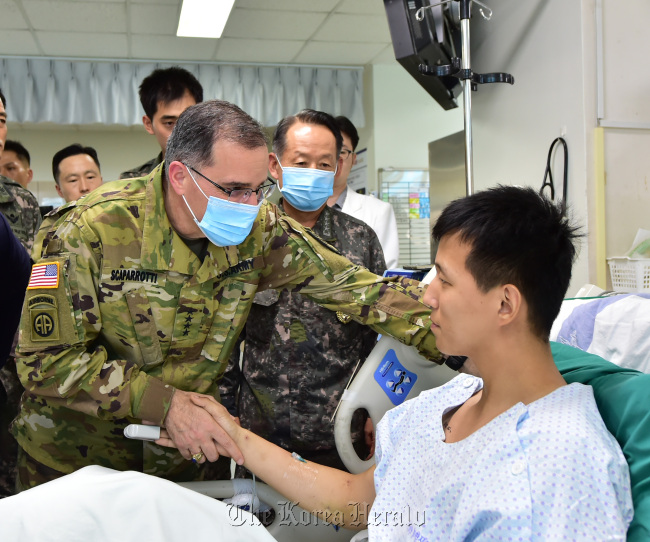Defense Minister Han Min-koo vowed Wednesday to scale up loudspeaker broadcasts in the Demilitarized Zone area and bolster psychological warfare against North Korea in retaliation for its suspected planting of land mines that inflicted serious injuries on South Korean troops last week.
The South Korean military resumed its propaganda program after more than 11 years on Monday, after the Joint Chiefs of Staff determined that North Korean soldiers had crossed the border and buried the three land mines that exploded on Aug. 4.
“We put two loudspeaker systems in operation as an initial step and will expand to full scale,” Han said at an emergency meeting of the National Assembly’s defense committee, adding that the broadcasts were taking place in four spots.
Ruling Saenuri Party Rep. Han Ki-ho, a retired three-star general, stressed that daily necessities and anti-Pyongyang leaflets should be sent to the North and propaganda electronic boards should be reactivated. The minister said he was looking into such measures.
 |
U.N. Command Commander Gen. Curtis Scaparrotti (left) visits Army staff sergeant Kim (right), who was seriously injured in a landmine blast while patrolling the Demilitarized Zone on Aug. 4, at Seoul National University Bundang Hospital in Seongnam, Gyeonggi Province, Wednesday. (Joint Chiefs of Staff) |
In a bid to facilitate search and scouting missions in the heavily fortified DMZ areas, the JCS said it would take a more offensive during operations and make them more unpredictable by changing times and locations, while overhauling the safety of their routes and removing plants to secure broader visibility.
Army Brig. Gen. Ahn Young-ho, who led the joint probe with the U.N. Command, has said that the blast site was easily eclipsed by the iron fence and surrounded by trees, making it difficult for South Korean soldiers to spot an enemy approaching, which the North apparently took advantage of.
“We’re seeking to improve our monitoring capabilities in key areas by gradually expanding badlands around guard posts and eliminating trees,” the JCS said in a report submitted to the parliamentary panel.
Later in the day, the defense committee unanimously adopted a resolution condemning Pyongyang’s provocation and urging an apology and preventive steps. The ruling Saenuri Party and main opposition New Politics Alliance for Democracy have proposed related texts.
The document stipulates the North’s mine-planting as a “clear military provocation in which it attempted to cause South Korean military casualties” which constitutes a direct violation of the multinational armistice and inter-Korean nonaggression pacts.
During the session, lawmakers pounded Han for what they called slack and belated responses to the mine attack and a confused approach to Pyongyang, citing the Unification Ministry’s failed offer of ministerial dialogue one day after the incident and the presidential National Security Council’s gathering four days later.
Though Seoul indeed appears to have few options for retaliatory measures, the border broadcasts have proved to be a source of intense unease for the regime, which maintains a tight grip over one of the world’s most reclusive societies.
In the “Voice of Freedom” program, the Defense Ministry chiefly releases news of the execution of elite military executives and other power struggles within the top echelons, information about free democracy and other regional and global issues, along with weather forecasts and music. Many defectors resettled in the South have testified that they had come to gain knowledge about the South and outside world for the first time through the broadcasts, which can travel as far as 10 kilometers.
The loudspeakers were taken down in 2004, following an agreement of the two Koreas’ militaries. They were reinstalled at 11 spots along the Military Demarcation Line following the North’s 2010 sinking of the South’s corvette Cheonan, which prompted Pyongyang to threaten to shoot them down, but have not been used since.
Last October, the two Koreas traded fire after the North shot heavy machine guns, apparently aiming at balloons containing flyers denouncing the regime, $1 bills, mini radios and other items.
In Washington, meanwhile, the U.S. also issued an official condemnation, calling the communist state’s act a breach of the truce accord.
“A UNC Special Investigation Team determined the North Korean People’s Army violated sections of the armistice agreement by placing land mines along a known ROK (South Korea) patrol route,” State Department deputy spokesman Mark Toner said in a statement.
“We join the UNC in condemning these violations of the armistice agreement.”
By Shin Hyon-hee (
heeshin@heraldcorp.com)




![[Herald Interview] 'Trump will use tariffs as first line of defense for American manufacturing'](http://res.heraldm.com/phpwas/restmb_idxmake.php?idx=644&simg=/content/image/2024/11/26/20241126050017_0.jpg)

![[Health and care] Getting cancer young: Why cancer isn’t just an older person’s battle](http://res.heraldm.com/phpwas/restmb_idxmake.php?idx=644&simg=/content/image/2024/11/26/20241126050043_0.jpg)

